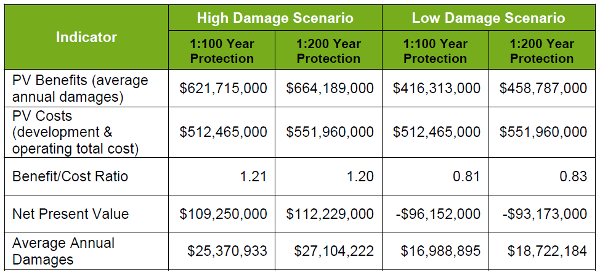The following is a summary of the report “Benefit/Cost Analysis of Flood Mitigation Projects for the City of Calgary: Glenmore Reservoir Diversion”. Please read the entire report for a full understanding of the Benefit/Cost Analysis.
The Glenmore Reservoir Diversion, also known as the Calgary Tunnel, will consist of
- an inlet structure,
- tunnel, and
- outlet structure.
The cost benefit analysis assumes the structure would align with Heritage Drive in Calgary and would operate whenever a 1:10 year event or greater would occur.
|
|
| The Glenmore Reservoir proposed project along the Heritage Drive alignment as drawn by Hatch Mott MacDonald. |
Project Costs
The IBI benefit/cost analysis for the Reservoir Diversion project was predominantly focused on tunnelling and underground components as they would dominate the overall cost and risk provisions. The costs were estimated “drawing from the Hatch Mott MacDonald proprietary cost estimating method TED (tunnel estimating database), which adopts estimating methods similar to those used by tunnelling contractors.”
The report listed the following items as costs included in their analysis:
- Procurement and mobilization of equipment & materials.
- Site setup.
- Outlet launch box excavation in soil and rock (includes secant pile wall).
- Shield TBM bored tunnel (includes assemble and disassemble costs) with precast concrete tunnel lining.
- Inlet shaft excavation (includes secant pile wall).
- Inlet transition section.
- Control shaft excavation (includes secant pile wall).
- Control gate area excavation.
- Construction water (tunnel inflows) treatment facilities and disposables.
- Final concrete lining for inlet and control shafts.
- Transport and disposal of excavation muck.
- Excavation including topsoil removal.
- Construction of concrete inlet/outlet structures.
- Fabrication, installation and commissioning of all gates (includes guides, provisions for hydraulic and control system).
- Service shaft (includes consideration of ladder, dewatering system, air circulation fan and a housing).
- Indirect costs.
- Construction contingency.
The estimated operational and maintenance costs were $1.8M to $2.0M; this is the same estimate used for all three of the projects.
Flood Damage Reduction
The IBI report states that the implementation of the Glenmore Reservoir Diversion project results in a reduction of average annual damages under the four cases as follows:
- 1:100 year level of protection under the higher damage scenario = $25,370,933
- 1:200 year level of protection under the higher damage scenario = $27,104,222
- 1:100 year level of protection under the lower damage scenario = $16,988,895
- 1:200 year level of protection under the lower damage scenario = $18,722,184
Benefit/Cost Analysis
The figure below highlights the key results of the benefit / costs analysis of the Glenmore Reservoir Diversion. It should be noted that this analysis was conducted solely based on economic costs and does not take social costs, or environmental impact into account.

The Glenmore Reservoir Diversion only achieves a positive Benefit/Cost Ratio in the high damage scenarios. As a result the IBI study ranks this project third, behind the other two mitigation projects.
The IBI study also mentions that the Glenmore Reservoir Diversion is the project with the highest level of uncertainty with respect to costs. The study mentioned “recent cost escalations associated with the City of Calgary airport runway tunnel (greater than two times the original estimate) provides a good example of … concern.”
Request for feedback
What are your thoughts on the Glenmore Reservoir Diversion project Benefit/Cost study?
Please contact the Alberta WaterPortal by email, or through the comments below. Feedback is accepted until March 31st. All feedback will be summarized and provided back on the WaterPortal and to the Government of Alberta.
